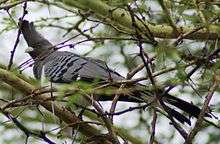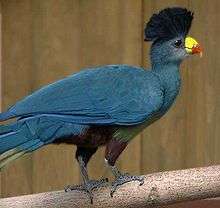Turaco
| Turacos and relatives Temporal range: Oligocene - Holocene, 24–0 Ma | |
|---|---|
.jpg) | |
| Guinea turaco, Tauraco persa, at Birds of Eden aviary, South Africa | |
| Scientific classification | |
| Kingdom: | Animalia |
| Phylum: | Chordata |
| Class: | Aves |
| Clade: | Otidimorphae |
| Order: | Musophagiformes Seebohm, 1890 |
| Family: | Musophagidae Lesson, 1828 |
| Genera | |
| Synonyms | |
|
Apopempsidae | |
The turacos make up the bird family Musophagidae (literally "banana-eaters"), which includes plantain-eaters and go-away-birds. In southern Africa both turacos and go-away-birds are commonly known as louries. They are semi-zygodactylous – the fourth (outer) toe can be switched back and forth. The second and third toes, which always point forward, are conjoined in some species. Musophagids often have prominent crests and long tails; the turacos are noted for peculiar and unique pigments giving them their bright green and red feathers.
Traditionally, this group has been allied with the cuckoos in the order Cuculiformes, but the Sibley-Ahlquist taxonomy raises this group to a full order Musophagiformes. They have been proposed to link the hoatzin to the other living birds,[1] but this was later disputed.[2] Recent genetic analysis have strongly supported the order ranking of Musophagiformes.[3][4][5]
Musophagids are medium-sized arboreal birds endemic to sub-Saharan Africa, where they live in forests, woodland and savanna. Their flight is weak, but they run quickly through the tree canopy. They feed mostly on fruits and to a lesser extent on leaves, buds, and flowers, occasionally taking small insects, snails, and slugs. As their name suggests, turacos enjoy bananas and can become so tame as to be hand-fed. They are also partial to grapes and pawpaw (papaya).
They are gregarious birds that do not migrate but move in family groups of up to 10. Many species are noisy, with the go-away-birds being especially noted for their piercing alarm calls, which alert other fauna to the presence of predators or hunters; their common name refers to this. Musophagids build large stick nests in trees, and lay 2 or 3 eggs. The young are born with thick down and open, or nearly-open, eyes.[6]
Morphology

Most turacos are medium-sized birds – an exception being the large great blue turaco – with long tails and short, rounded wings. They range in length from 40 to 75 cm (16–30 in). Their flight is weak, but they are strong climbers and are able to move nimbly on branches and through vegetation. Juveniles have claws on the wings that help them climb.[7][8][9] They have a unique foot arrangement, where the fourth toe can be brought around to the back of the foot where it almost touches the first toe, or brought around so that it is near the second and third. In spite of this flexibility the toe is actually usually held at right angles to the axis of the foot.[10]
The plumage of go-away-birds and plantain-eaters is mainly grey and white. The turacos on the other hand are brightly coloured birds, usually blue, green or purple. The green colour in turacos comes from turacoverdin, the only true green pigment in birds known to date. Other "greens" in bird colors result from a yellow pigment such as some carotenoid, combined with the prismatic physical structure of the feather itself which scatters the light in a particular way and giving a blue colour. Turaco wings contain the red pigment turacin, unlike in other birds where red colour is due to carotenoids. Both pigments are derived from porphyrins and only known from the Musophagidae at present, but especially the little-researched turacoverdin might have relatives in other birds. The incidence of turacoverdin in relation to habitat is of interest to scientists, being present in forest species but absent in savanna and acacia living species.[10]
Little is known about the longevity of wild turacos, but in captivity they are proving to be exceptionally long-lived, easily living to 30 in captivity. A bird in the Cotswold Wildlife Park collection approached its 37th year.[11]
Evolution and systematics
The fossil genus Veflintornis is known from the Middle Miocene of Grive-Saint-Alban (France). It was established as Apopempsis by Pierce Brodkorb in 1971, but this is preoccupied by Schenkling's 1903 use of the name for some beetles. "Apopempsis" africanus (Early Miocene of Kenya) might also belong there.[12]
Further fossil material of putative musophagids was found in Egypt as well as in Late Oligocene deposits at Gaimersheim (Germany) and Middle Miocene deposits at Grive-Saint-Alban[13] and Vieux-Collonges (both France).[12] While it is not entirely certain that these fossils indeed are of turacos, it nonetheless appears as if the family evolved in the Oligocene of central Europe or perhaps northern Africa, and later on shifted its distribution southwards. The climate of those European regions during the late Paleogene was not too dissimilar to that of (sub)tropical Africa today; the Saharan desert was not yet present and the distance across the Mediterranean was not much more than what it is today. Thus such a move south may well have been a very slow and gradual shifting of a large and continuous range.

Corythaeola cristata
The Early Eocene Promusophaga was initially believed to be the oldest record of the turacos; it was eventually reconsidered a distant relative of the ostrich and is now in the ratite family Lithornithidae. Filholornis from the Late Eocene or Early Oligocene of France is occasionally considered a musophagid, but its relationships have always been disputed. It is not often considered a turaco anymore in more recent times and has been synonymised with the presumed gruiform Talantatos, though it is not certain whether this will become widely accepted.[12]
Species
The living species of Musophagidae, arranged in taxonomic sequence, are:
Order Musophagiformes
- Family Musophagidae
- Subfamily Corythaeolinae
- Genus Corythaeola
- Great blue turaco, Corythaeola crostata
- Genus Corythaeola
- Subfamily Criniferinae
- Genus Corythaixoides
- White-bellied go-away-bird, Corythaixoides leucogaster
- Grey go-away-bird, Corythaixoides concolor
- Bare-faced go-away-bird, Corythaixoides personatus
- Genus Crinifer
- Western plantain-eater, Crinifer piscator
- Eastern plantain-eater, Crinifer zonurus
- Genus Corythaixoides
- Subfamily Musophaginae
- Genus Gallirex
- Ruwenzori turaco, Gallirex johnstoni
- Purple-crested turaco, Gallirex porphyreolophus
- Genus Pseudopoetus
- Yellow-billed turaco, Pseudopoetus macrorhynchus
- Genus Musophaga
- Violet turaco, Musophaga violacea
- Ross's turaco, Musophaga rossae
- Genus Menelikornis
- White-cheeked turaco, Menelikornis leucotis
- Genus Tauraco
- Bannerman's turaco, Tauraco bannermani
- White-crested turaco, Tauraco leucolophus
- Red-crested turaco, Tauraco erythrolophus
- Guinea turaco, Tauraco persa
- Knysna turaco, Tauraco corythaix
- Livingstone's turaco, Tauraco livingstonii
- Fischer's turaco, Tauraco fischeri
- Black-billed turaco, Tauraco schuettii
- Schalow's turaco, Tauraco schalowi
- Hartlaub's turaco, Tauraco hartlaubi
- Ruspoli's turaco, Tauraco ruspolii
- Genus Gallirex
- Subfamily Corythaeolinae
Interaction with humans
The brilliant crimson flight feathers of turacos have been treasured as status symbols to royalty and paramount chiefs all over Africa. They are recorded as being valued by the Swazi and Zulu royal families.[14]
See also
- Hoatzin, a convergently evolved bird in the order Opisthocomiformes which is a large-crested arboreal herbivore whose nestlings also use wing claws for climbing.[7]
Footnotes
- ↑ Hughes & Baker (1999)
- ↑ Sorenson et al. (2003)
- ↑ Ericson, P.G.P.; et al. (2006). "Diversification of Neoaves: integration of molecular sequence data and fossils" (PDF). Biology Letters. 2 (4): 543–547. doi:10.1098/rsbl.2006.0523. PMC 1834003
 . PMID 17148284.
. PMID 17148284. - ↑ Hackett, S.J.; et al. (2008). "A Phylogenomic Study of Birds Reveals Their Evolutionary History". Science. 320 (5884): 1763–1768. doi:10.1126/science.1157704. PMID 18583609.
- ↑ Jarvis, E.D.; et al. (2014). "Whole-genome analyses resolve early branches in the tree of life of modern birds". Science. 346 (6215): 1320–1331. doi:10.1126/science.1253451. PMC 4405904
 . PMID 25504713.
. PMID 25504713. - ↑ Marchant, S. (1991). Forshaw, Joseph, ed. Encyclopaedia of Animals: Birds. London: Merehurst Press. p. 125. ISBN 1-85391-186-0.
- 1 2 Fain, Matthew G. & Houde, Peter (2004). "Parallel radiations in the primary clades of birds" (PDF). Evolution. 58 (11): 2558–2573. doi:10.1554/04-235. PMID 15612298. Retrieved 2016-07-08.
- ↑ "Violaceous Touraco" (PDF). rosamondgiffordzoo.org. 2010-03-01. Retrieved 2016-07-08.
- ↑ "TURACO TAG HUSBANDRY MANUAL" (PDF). aviansag.org. 1998-08-18. Retrieved 2016-07-08.
- 1 2 Turner, Donald (1997), "Family Musophagidae (Turacos)", in del Hoyo, Josep; Elliott, Andrew; Sargatal, Jordi, Handbook of the Birds of the World. Volume 4, Sandgrouse to Cuckoos, Barcelona: Lynx Edicions, pp. 480–508, ISBN 84-87334-22-9
- ↑ Originally from Nigel Hewston, discussed at the ITS AGM in spring 2012 (at the same venue)
- 1 2 3 Mlíkovský (2002)
- ↑ "TT 149", a proximal left and a distal right tibiotarsus of a bird similar in size to living Tauraco: Ballmann (1969)
- ↑ ITS Magazine, autumn 2003 (20), www.turacos.org
References
- Ballmann, Peter (1969). "Les Oiseaux miocènes de la Grive-Saint-Alban (Isère) [The Miocene birds of Grive-Saint-Alban, Isère]". Geobios. 2: 157–204. doi:10.1016/S0016-6995(69)80005-7. (French with English abstract)
- International Turaco Society (Magazines 1993–2012), also website 2001, www.turacos.org
- Mlíkovský, Jirí (2002): Cenozoic Birds of the World, Part 1: Europe. Ninox Press, Prague. ISBN 80-901105-3-8 PDF fulltext
- Hughes, Janice M.; Baker, Allan J. (1999). "Phylogenetic relationships of the enigmatic hoatzin (Opisthocomus hoazin) resolved using mitochondrial and nuclear gene sequences" (PDF). Molecular Biology and Evolution. 16 (9): 1300–1307. doi:10.1093/oxfordjournals.molbev.a026220. PMID 10486983.
- Sorenson, Michael D.; Oneal, Elen; García-Moreno, Jaime; Mindell, David P. (2003). "More Taxa, More Characters: The Hoatzin Problem is Still Unresolved". Molecular Biology and Evolution. 20 (9): 1484–1499. doi:10.1093/molbev/msg157. PMID 12777516. Supplementary Material
External links
| Wikimedia Commons has media related to Musophagidae. |
- International Touraco Society
- Turaco videos on the Internet Bird Collection